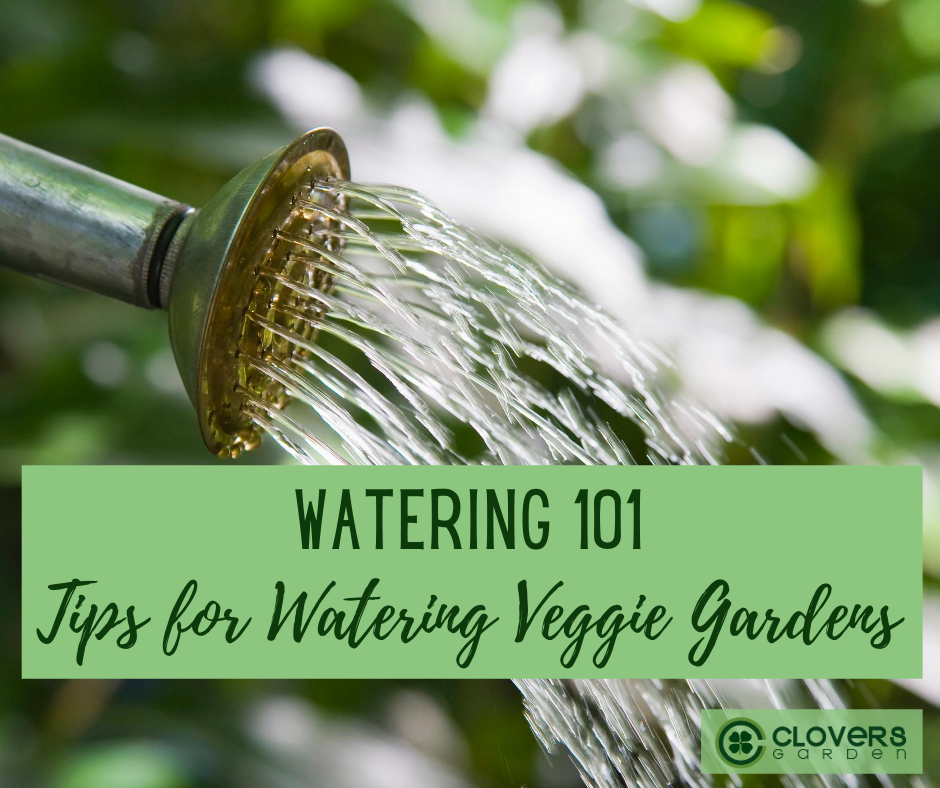Watering the garden seems like it should be pretty straightforward. If the soil looks dry, you should water, right? It’s not that simple and infrequent or inconsistent watering stresses your plants and can even damage your harvest. Rainfall is always our first choice for watering (which makes rain barrels a must-have) but at some point you may need water from an external source. This article will explain best watering practices and share tips on how to conserve water while nourishing your plants.
When to Water Your Garden.
Begin with an eye towards the weather – if you’ve had good soaking rains (1” or more) then you don’t need to water; if the weather’s been hot and windy, then you probably should water. Soil attributes also determine when to water: sandy, fast-draining soils need more frequent watering; heavier, water-retaining clay soils can go a little longer in between watering. The soil’s top appearance doesn’t always show the need for water – remember that plants’ roots go deep down and that’s where the moisture level is important. Poke into the soil with your finger or a measuring stick – if it’s dry below 1/2”, then it’s time to water.
TIP: If possible, avoid watering in the late evening or at night – the plant leaves will sit all night with moisture on them which can lead to diseases and mold growth.
Give Your Plants the Best Water.
Chemically-treated or softened water is not ideal for your plants. If you are using city water, filter your water by attaching an inline water filter between your outside faucet and hose. Designed for use in RVs and boats, these inexpensive filters will last all summer and will filter out most of the chemicals that municipalities use to treat water. These can be bought online or at your local sporting goods store.
Soaker Hoses are a Must-Have.
Drip irrigation (aka soaker hoses) make your watering life so much easier and it’s better for your plants. Within less than an hour, you can arrange soaker hoses throughout your garden beds and they will stay in place all summer (make sure you to secure with landscaping pins). Once in place, follow the timing directions on the instructions that come with your hose. This method of water keeps soil from splashing on the leaves, protects the soil from eroding around the base of the plant, and does a much better job at getting water deep into the soil. The one caveat with soaker hoses is you will not be able to deliver water-dissolved fertilizer to the plants — create a reminder schedule so you’ll remember to add this step with manual watering every couple of weeks.
Where to Water Veggie Plants.
So much of the “how” depends on what you’re watering. Grass requires a broad sprinkler approach; trees and bushes require a soaking that reaches the root perimeter; and garden veggies and flowers require consistent watering. Research what you’re watering first but in general try to avoid splashing water on the plants’ leaves and focus on the base of the plant. Use mulch around plants, too, to help retain moisture longer. Aim for consistent moisture at that ½” depth and don’t just automatically water every day. Remember, too, that containers will dry out much more quickly than garden beds.
How to Measure Water Amounts.
It’s easy to calculate how much water you’re giving each plant. Start with a five-gallon bucket; put in your hose or hold your sprayer open into the bucket; and time how long it takes to fill the bucket. If it takes five minutes, you’ll know you’re watering at one gallon per minute.

